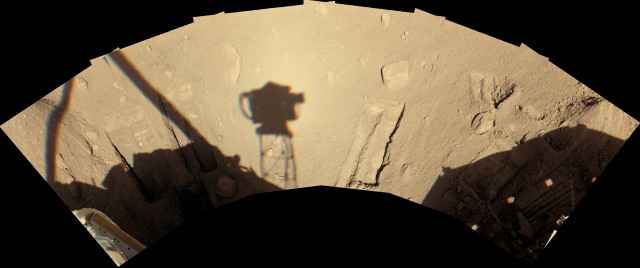90 Days on Mars: Phoenix Lander Sends Martian Postcard

As the sun dipslower in the Martian sky with each passing day, NASA?s solar-powered Phoenix Mars Landertook time this week to send a postcard of sorts to scientists on Earth aftermore than three months studying the red planet.
Phoenix beamedhome a view of its trench-filled worksite after surpassing the 90-day mark ofits initial mission to hunt for water ice buried beneath the barren arcticplains of Mars. While the Martian days, or sols, are getting colder and the sunexpected to dip completely below the horizon tonight for the first time since Phoenixlanded in late May, the probe itself is in fine health, mission managers said.
?It?s doingfabulously,? said Barry Goldstein, NASA?s Phoenix project manager at the JetPropulsion Laboratory in Pasadena, Calif. ?But I?ve made it clear to thescience team that the warranty?s over.?
Goldsteintold SPACE.com Thursday that Phoenix scientists are using the spacecraftto collect as much data as possible through the end of September, when itsmission extension concludes, and have submitted a proposal for a secondextension through mid-November should the probe survive that long. Researchers at the University of Arizona in Tucson are overseeing the mission.
?Thevehicle is not going to tip over and die,? Goldstein said. ?But we?re gettingto the point where we?re going to start seeing the creaks and groans.?
Phoenixlanded in the northern Vastitas Borealis region of Mars on May 25 and begana planned three-month mission to search for water ice using a shovel-tippedrobotic arm and a science tool kit that included eight small ovens and a wetchemistry lab with four beakers, each the size of a teacup. Researchers hopedthat those tools and a Canadian-built weather station would find definitiveproof of local water ice and help determine if the Martian arctic could haveonce served as a welcome oasis for primitive life.
Since thattime, Phoenix has successfully scooped, touched and tasted bits ofactual Martian ice even as mission scientists race to collect moreinformation from the probe?s arctic landing site before winter closes in onMars.
Breaking space news, the latest updates on rocket launches, skywatching events and more!
The days,Goldstein said, are steadily growing colder.
DuringPhoenix?s first 50 days on Mars, the lander experienced temperatures that dipped downto minus 80 degrees Celsius (minus 112 degrees Fahrenheit) at their coldest. Now,the probe is experiencing temperatures as low as minus 85 degrees C (minus 121 degreesF) and its going to keep getting colder, Goldstein added.
The amountof power generated by Phoenix?s two solar arrays is also on the decline, withthe probe currently generating about 2,500 watt-hours each day - or about 1,000watt-hours less than when it landed - because of waning sunlight. The absolute minimum needed for Phoenix toperform the most basic operations is about 1,000 watt-hours, mission managerssaid.
?We?repredicting that?s the end of mission,? Goldstein said, adding that currentprojections put that power benchmark in November.
But fornow, the $420 million Phoenix isforging ahead to study the Martian arctic, and is expected to use one of itstwo remaining wet chemistry lab beakers to study a sample of Mars thisSaturday, Goldstein added. There are also four remaining ovens that stand readyto bake Martian samples and determine their composition, but it may be achallenge to fill all of them before the current mission extension ends nextmonth, he said.
?We?re inthat mode now where we?re collecting a lot of data,? Goldstein said. ?Everybodyis so busy trying to make hay as the sun shines, literally and figuratively,that we haven?t had a chance to take a breath to see what the biggest science findhas been.?
Goldsteinalso worked on NASA?s long-lived Mars Exploration Rovers (MER) Spirit andOpportunity, which have been exploring different parts of the red planet sinceJanuary 2004, and said it?s a somewhat sad and weird feeling to know that thoseolder spacecraft will outlive Phoenix.
But while Spiritand Opportunity, the latter of which beganclimbing out of the vast Victoria Crater this week, have returned thousandsof images of Martian days and evenings from the planet?s equatorial regions, Phoenix?sviews from the planet?s arctic circle stand apart.
?We havethose shots from MER of Martian sunsets and sunrises, but its something aboutthe arctic,? Goldstein said. ?There?s just something about that.?
- Video - Phoenix Speaks!
- Video - Digging on Mars
- The Top 10 Martian Landings of All Time

Tariq is the award-winning Editor-in-Chief of Space.com and joined the team in 2001. He covers human spaceflight, as well as skywatching and entertainment. He became Space.com's Editor-in-Chief in 2019. Before joining Space.com, Tariq was a staff reporter for The Los Angeles Times covering education and city beats in La Habra, Fullerton and Huntington Beach. He's a recipient of the 2022 Harry Kolcum Award for excellence in space reporting and the 2025 Space Pioneer Award from the National Space Society. He is an Eagle Scout and Space Camp alum with journalism degrees from the USC and NYU. You can find Tariq at Space.com and as the co-host to the This Week In Space podcast on the TWiT network. To see his latest project, you can follow Tariq on Twitter @tariqjmalik.
